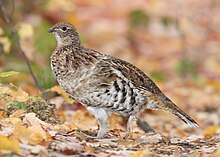Ruffed grouse
| Ruffed grouse | |
|---|---|
 |
|
| Algonquin Provincial Park, Ontario | |
| Scientific classification | |
| Kingdom: | Animalia |
| Phylum: | Chordata |
| Class: | Aves |
| Order: | Galliformes |
| Family: | Phasianidae |
| Subfamily: | Tetraoninae |
| Genus: |
Bonasa Stephens, 1819 |
| Species: | B. umbellus |
| Binomial name | |
|
Bonasa umbellus (Linnaeus, 1766) |
|
| Synonyms | |
|
|
The ruffed grouse (Bonasa umbellus) is a medium-sized grouse occurring in forests from the Appalachian Mountains across Canada to Alaska. It is non-migratory. It is the only species in the genus Bonasa.
The ruffed grouse is sometimes incorrectly referred to as a "partridge", an unrelated phasianid, and occasionally confused with the grey partridge, a bird of open areas rather than woodlands.
The ruffed grouse is the state bird of Pennsylvania, United States.
Bonasa umbellus was first described by Linnaeus who classified it as Tetrao umbellus, placing it in a subfamily with Eurasian grouse. The subfamily Bonasa was applied by British naturalist John Francis Stephens in 1819. Ruffed grouse is the preferred common name because it applies only to this species. Misleading vernacular names abound, however, and it is often called partridge (sometimes rendered pa'tridge, or shortened to pat), pheasant, or prairie chicken, all of which are properly applied to other birds. Other nicknames for ruffed grouse include drummer or thunder-chicken.
There are 14 recognized subspecies of ruffed grouse:
These chunky, medium-sized birds weigh from 450–750 g (0.99–1.65 lb), measure from 40 to 50 cm (16 to 20 in) in length and span 50–64 cm (20–25 in) across their short, strong wings. Ruffed grouse have two distinct morphs, grey and brown. In the grey morph, the head, neck and back are grey-brown; the breast is light with barring. There is much white on the underside and flanks, and overall the birds have a variegated appearance; the throat is often distinctly lighter. The tail is essentially the same brownish grey, with regular barring and a broad black band near the end ("subterminal"). Brown-morph birds have tails of the same color and pattern, but the rest of the plumage is much more brown, giving the appearance of a more uniform bird with less light plumage below and a conspicuously grey tail. There are all sorts of intergrades between the most typical morphs; warmer and more humid conditions favor browner birds in general.
...
Wikipedia

